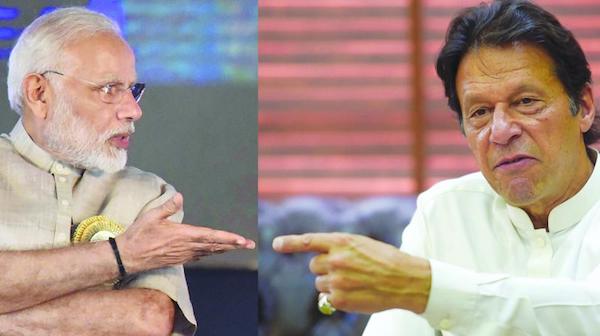

WILL INDIA CAPITALIZE ON “USA-INDIA CLOSE ALLY” STATUS?
WILL INDIA SEIZE THE OFFER OF THE USA TO TRANSFER 100% OF US TECHNOLOGY?
WHAT LESSONS INDIA LEARNED AFTER THE AIR SKIRMISHES WITH PAKISTAN ON 26th and 27th FEBRUARARY?
“Prime Minister Modi must take full advantage of ‘CLOSE ALLY’ relationship and start doing business with the USA that will benefit both. China opened its economy in 1979 and within 20 years it became the second economic power in the world. India has excellent credit and therefore India can mobilize resources needed for modernizing India and its defense. India must embrace capitalism as China did, and not continue to fool around with socialism”.
At the outset, I must say that this is the first time India received worldwide support since its independence in 1947.During the end of Harry Truman’s Presidency, Pakistan aligned with the USA by signing a Mutual Security Agreement. President Trump changed this after his election. He canceled aid to Pakistan and gave ultimatum to Pakistan to get rid of all terrorist organizations, including Jaish-e-Mohammed and Lashhar-e-Taiba .These two major Pakistan’s homegrown terror organizations with the implied support of Pakistan’s military and the I.S.I. (intelligence agency) attacked the Indian Parliament in 2001. In 2008, they tried to seize Mumbai and thru terror tactics killed 165 Indians and foreign nationals. Since then, various governments of Pakistan refused to mete out justice to the assailants, the leaders of Jaish-e-Mohammed and Lashkar-e-Taiba. Pakistan’s military and the I.S.I. have been ruling Pakistan. The military has installed Prime Minister Imran Khan. The so-called civil government and its parliament are mere window-display.
PAKISTAN HAS BEEN VIOLATING THE LINE OF CONTROL BETWEEN INDIAN KASHMIR AND PAKISTAN OCCUPIED KASHMIR
Pakistan has been violating the Line of Control systematically resulting in thousands of deaths of Indian soldiers during the past two decades. On 14th February, Pakistan used Jaish-e-Mohammed as its proxy and killed 41 Indian military police. Prime Minister Modi said, “Enough is Enough. India cannot and will not tolerate.” And he ordered his military to take action.
USA-INDIA CLOSEST ALLY STATUS IN PLAY
Before India took military action, India created a favorable political atmosphere in the world that pumped out political support from the sole superpower, the USA. The National Security Adviser, John Bolton and the Secretary of State, Pompei extended vehement support. This was followed immediately by discussion in the U.S.Congress. Several leaders of the U.S.Senate and the House of Representatives accused Pakistan and offered their overwhelming support to India. There was a general consensus that Pakistan must take action to get rid of all terrorists. The leadership of the USA was followed by the European Union, Australia, Japan, Canada and many countries. The United Nations discussed the matter and asked Pakistan to get rid of Jaish-e-Mohammed and Lashkar-e-Taiba. I am explaining to show that India did not act hastily and alone. It even had the implied support of China.
INDIA NEUTRALIZED CHINESE SUPPORT OF PAKISTAN
It must be pointed out that China chose not to support Pakistan against Indian attacks. Instead, China appealed to both India and Pakistan to use restraint and settle the differences. But China emphasized that Pakistan must get rid of its terrorists. It is also important to note that China refused to intervene or support Pakistan in 1971, when India used force to liberate East Pakistan and created Bangladesh. This is in spite of the historical fact that India and China had fought in 1962 on territorial differences.
Pakistan had banked on Chinese support and was disappointed. Significantly, China did not even mention the territorial violation of Pakistan by India. Equally, Pakistan was furious that the U.N. was silent when India attacked Pakistan’s airspace and violated its sovereignty.
It is interesting that India’s Foreign Minister, Sushma Swaraj timed her strategic meeting in Peking during the crisis, and she told her counterpart:
“No military installations were targeted. The limited objective of the preemptive strike was to act decisively against the terrorist infrastructure of Jaish-e-Mohammed in order to pre-empt another terror attack on India. India does not wish to see further escalation of the situation. India will continue to act with responsibility and restraint.”
LESSONS LEARNED FROM THE AIR SKIRMISHES WITH PAKISTAN
- INTELLIGENCE: On the 26th attack on Balakot, Pakistan, Indian intelligence failed to target the right place for bombing.
- TECHNOLOGY: On the 27th dogfight, the Indian pilot, Abhinandan Varthaman, was downed because his MIG-21 was no match to Pakistan’s F-16. Even the latest MIG-35 is no match to F-16. Thus, superior technology matters.
- PUBLIC RELATIONS: Public Relations is also very important. P stands for Performance and R stands for Reporting. Indian bureaucrats failed to report. The media and the public wanted to know when and where F-16 plane was downed and how. The speculation is the Indian pilot before he was downed also inflicted damage to the F-16 forcing its pilot to go down. Also, when India failed to identify the target in Balakot, India claimed it had destroyed the Jaish-e-Mohammed’s training camp of 300.
RECOMMENDATIONS FOR ACTION TO CAPITALIZE ON “INDIA-USA CLOSE ALLY” RELATIONSHIP
- India must take bold steps to make its economy modern and grow its GDP @10% minimum for the next decade.This will create multi millions of jobs badly needed by the unemployed.
- Liberalize and open the economy.Make it most business friendly and create most favorable environment for foreign investment.
- Modern warfare is won using sophisticated technologies and superior intelligence.India must be prepared to make dynamic changes in its military preparedness. India must once and for all decide to buy the best and most superior military hardware from the USA. India should be prepared not to depend on Russia. Indian factories that make Russian MIGs are outmoded and should be closed. What is the use of buying cheap or paying in rupees if you cannot win the war?
- China’s defense budget is $175 billion, India’s is $45 billion Out of India’s budget, $28 billion is allocated for salaries and pensions, leaving only $17 billion for military hardware. To protect India’s sovereignty and its international standing, India has no choice but to increase its defense budget to $175 billion.
- India has ammunitions to last only for 10 days of war.This is precarious and not acceptable.
- India should immediately allocate $100 billion to buy sophisticated military hardware, especially, quantity fighter planes to defend against China and Pakistan.
NEXT STEP: Prime Minister Modi should make a definite schedule for President Trump to visit India for at least three days. He will be accompanied by a large delegation of Fortune 500 corporations, investment banks etc. During the visit Prime Minister Modi could discuss with President Trump, India’s requirements to build its economy and defense. Instead of India negotiating to buy directly from American military hardware manufacturers, President Trump could negotiate as he is good at cutting the price to the bottom. He helped Vietnam finalize purchase of planes from Boeing during the North Korean summit held in Hanoi.
President Trump’s grand strategy is to balance against the aggressive and growing Chinese influence in Asia. He is interested in replacing China with India as a source for consumer and industrial goods. However, today India does not have the necessary infrastructure to manufacture on large scale. India must deliver water and energy to all for 24/7. India has a large supply of engineers and managers. India has a comparative advantage with China . India must privatize its public sector corporations and release resources. Lockheed Martin, United Technologies, Boeing, Raytheon and others are ready and willing to manufacture in India. Making weapons in India has a comparative advantage especially with an oversupply of professional engineers and managers.
Prime Minister Modi must take full advantage of ‘CLOSE ALLY’ relationship and start doing business with the USA that will benefit both. China opened its economy in 1979 and within 20 years it became the second economic power in the world. India has excellent credit and therefore India can mobilize resources needed for modernizing India and its defense. India must embrace capitalism as China did, and not continue to fool around with socialism.
(Ven Parameswaran, MBA, Columbia University, lives in Scarsdale, N.Y. He is a Senior Adviser to Imagindia Institute, a think tank in New Delhi)





Be the first to comment